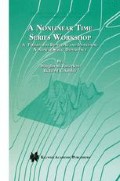Abstract
Angle glint or “glint noise” refers to fluctuations in the measured angle of arrival of backscattered electromagnetic waves transmitted from a radar device. Active sonar tracking systems are also subject to glint noise for the same physical reason: When a target consists of many point reflectors, the backscattered waves from the individual elements interfere with one another to produce fluctuations in the echo signal arriving at the receiver. As the aspect angles of the individual elements change, the relative amplitudes and phases of the scattered components also change, leading to a scintillation in the amplitude of the return signal and glint noise components in the measurement of angle. These tracking errors are most pronounced at short and intermediate target ranges: at long range the target appears to be a single point within the resolution cell of the tracking system. Glint induced measurement errors can result in a situation where the tracking point lies entirely outside the physical confines of the target.
This chapter draws heavily from D.M. Patterson (1991) “Third and Higher-Order Dependence in Active Sonar Tracking Errors. ” FINAL REPORT, prepared for Naval Underwater Systems Center, Under Contract No. N70024-0193-0441.
Access this chapter
Tax calculation will be finalised at checkout
Purchases are for personal use only
Preview
Unable to display preview. Download preview PDF.
References
Delano, R. (1953) “A Theory of Target Glint or Angular Scintillation in Radar Tracking,” Proceedings of the I.R.E 41,1778–1784.
Martin, R. and D. Thompson (1982) “Robust-Resistent Spectrum Estimation,” Proceedings of the IEEE 70,1097–1115.
Muchmore, R. (1960) “Aircraft Scintillation Spectra,” IRE Transactions on Antennas and Propagation AR-8(2), 201–212.
Ostrovityanov, R. and F. Basalov (1985) Statistical Theory of Extended Radar Targets, translated by W. Barton and D. Barton, Artech House, Inc., Dedham, MA.
Author information
Authors and Affiliations
Rights and permissions
Copyright information
© 2000 Springer Science+Business Media New York
About this chapter
Cite this chapter
Patterson, D.M., Ashley, R.A. (2000). Glint Tracking Errors in Radar. In: A Nonlinear Time Series Workshop. Dynamic Modeling and Econometrics in Economics and Finance, vol 2. Springer, Boston, MA. https://doi.org/10.1007/978-1-4419-8688-7_7
Download citation
DOI: https://doi.org/10.1007/978-1-4419-8688-7_7
Publisher Name: Springer, Boston, MA
Print ISBN: 978-1-4613-4665-4
Online ISBN: 978-1-4419-8688-7
eBook Packages: Springer Book Archive

